As December 2025 approaches, schools nationwide are buzzing with festive energy. Those blank classroom doors are just begging to be transformed into winter wonderlands, character showcases, and holiday magic portals. I’ve spent fifteen years judging school door decoration contests and consulting with teachers on their holiday displays, and lemme tell you—2025 is shaping up to be the year of immersive, interactive, and eco-conscious door decor.
The humble classroom door has evolved from simple wreath hangings to elaborate themed installations that incorporate technology, sustainability, and curriculum connections. These aren’t just decorations anymore; their learning opportunities dressed in tinsel and joy.
Nothing brings school communities together quite like these colorful corridor transformations. Parents volunteer, students collaborate, and teachers channel their inner artists to create memorable experiences that last far beyond the holiday season. These door designs become the backdrop for countless memory-making moments and end-of-year photos that families will cherish for years.
Contest-Winning Door Decoration Ideas
1. Interactive Story Portal
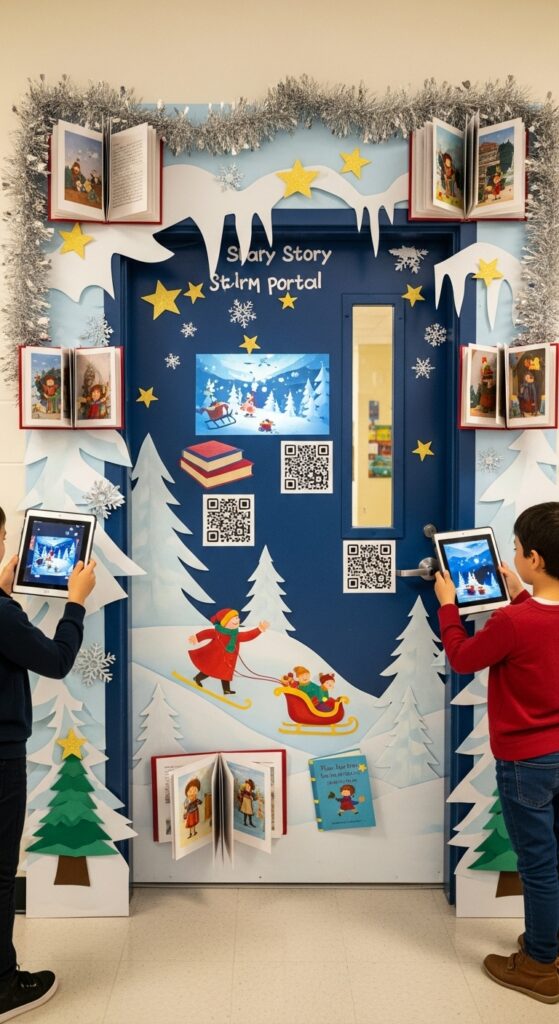
Imagine a door that literally transports students into a holiday story through embedded QR codes and augmented reality elements. The physical door serves as the foundation, decorated with dimensional paper craft scenes from a beloved holiday tale.
The magic happens when students scan different elements with the school’s tablets. Characters spring to life, narration begins, and interactive quizzes appear. Teachers across districts are loving this blend of traditional crafting and digital innovation. The best versions connect with actual reading curriculum goals, making this both festive and educational.
Many schools have started collaborating with their technology departments to create custom AR experiences unique to their communities. Dont underestimate how engaging this can be for students of all ages—even teenagers who normally resist holiday activities get drawn into the tech aspects of these displays.
2. Community Cultural Celebration Door
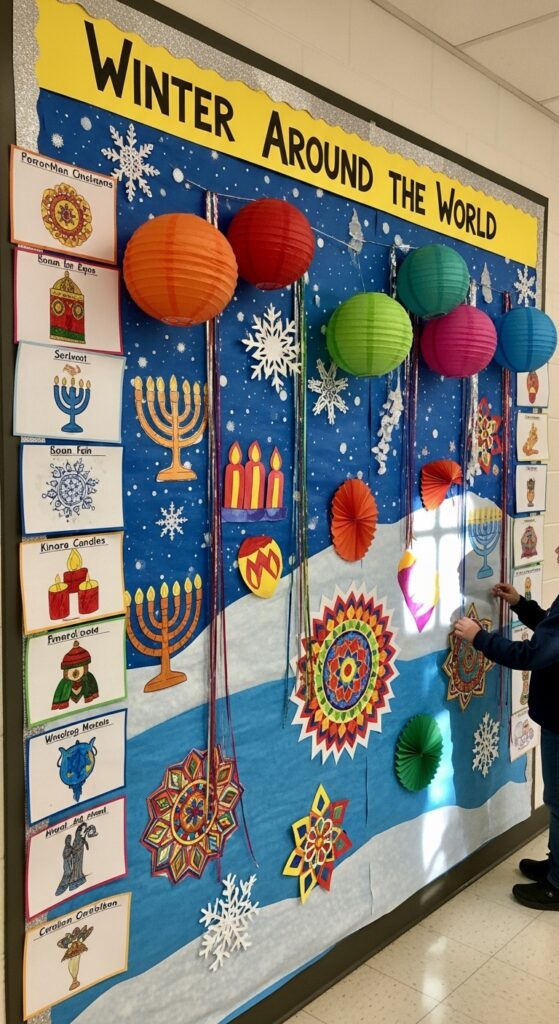
The most impactful contest entries in 2025 showcase the diverse holiday traditions represented within the school community. These doors feature a central winter scene that incorporates symbols, colors, and traditions from multiple cultural celebrations occurring during the winter months.
Student contributions make these displays special, with each child adding an element representing their family’s traditions. Small handwritten cards explaining each symbol provide educational context for viewers. The overall effect creates a gorgeous patchwork of traditions that celebrates diversity while maintaining a cohesive artistic vision.
Judges are increasingly favoring these inclusive approaches that go beyond the standard Santa-and-reindeer motifs. One middleschool in Portland won their district competition with a door that incorporated thirteen different cultural traditions, each researched and presented by student committees.
3. Sustainable Materials Wonderland
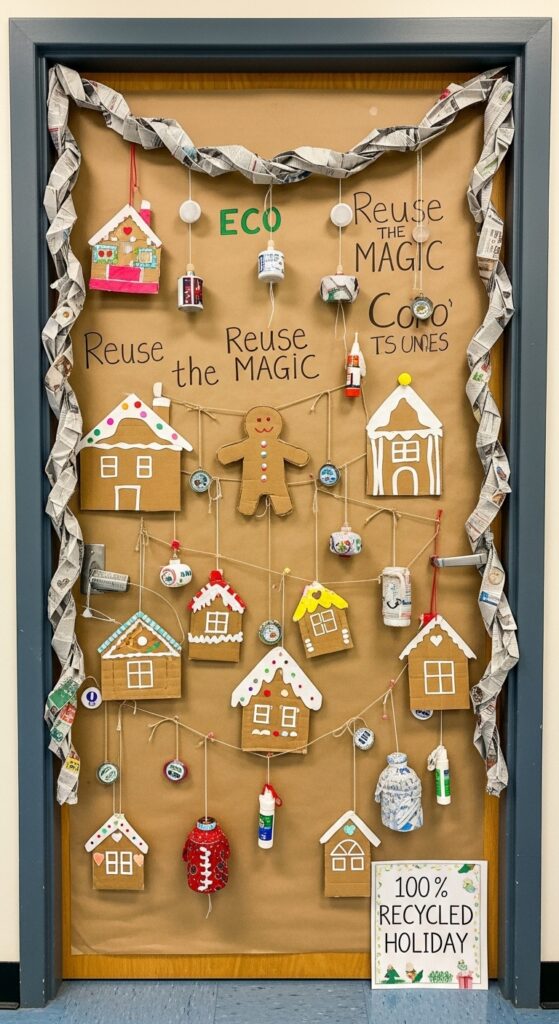
Environmental consciousness has reached holiday decorating in a major way. The most innovative schools are creating stunning door displays using entirely repurposed, recycled, or compostable materials. Think newspaper snowflakes, cardboard gingerbread houses, and bottle cap ornaments.
The creative constraints actually push designs to new levels of ingenuity. One teacher transformed plastic grocery bags into flowing snow drifts that cascaded from the door frame onto the hallway floor. Another used old homework assignments (after grading, of course!) to create hundreds of folded paper stars.
Documentation of the sustainable process has become part of the display itself, with small signs identifying material sources and explaining how the community contributed. These doors teach powerful lessons about consumption and creativity during a season often associated with excess.
4. Projection Mapping Christmas

The cutting edge of door decoration contests involves using small projectors to cast animated scenes onto basic white door coverings. The technology has become affordable enough for school budgets, and the results are absolutely magical.
During the day, the door might feature simple white paper with minimal physical decorations. But when the projector activates, the entire surface transforms with falling snow, dancing characters, or a cozy fireplace scene. Some advanced setups even incorporate motion sensors that change the projection when someone approaches.
The technical aspects do require planning and positioning, but tech-savvy teachers report that the wow-factor is well worth the effort. As one Virginia elementary school principal told me, “The gasps when students round the corner and see these animated doors makes all the extension cord wrangling worthwhile.”
5. 3D Pop-Out Sleigh Adventure

Dimension is everything in standout door decorations. The most impressive contest entries extend beyond the door frame, creating immersive environments that students can walk through or interact with. The sleigh adventure concept transforms the doorway into Santa’s sleigh, with the classroom beyond becoming the night sky.
Construction requires sturdy cardboard structures, painted backdrop scenes, and careful attention to safety considerations. The results create irresistible photo opportunities and transform ordinary school hallways into magical experiences. Some teachers add finishing touches like battery-operated “headlights” for the sleigh or recordings of sleigh bells that play when the door opens.
This concept works particularily well for classrooms that open to outdoor areas or larger spaces where the extended display won’t create traffic problems. The display essentially becomes a theatrical set piece that frames the everyday actions of entering and exiting the classroom.
Preschool-Friendly Door Decorations
6. Handprint Holiday Tree
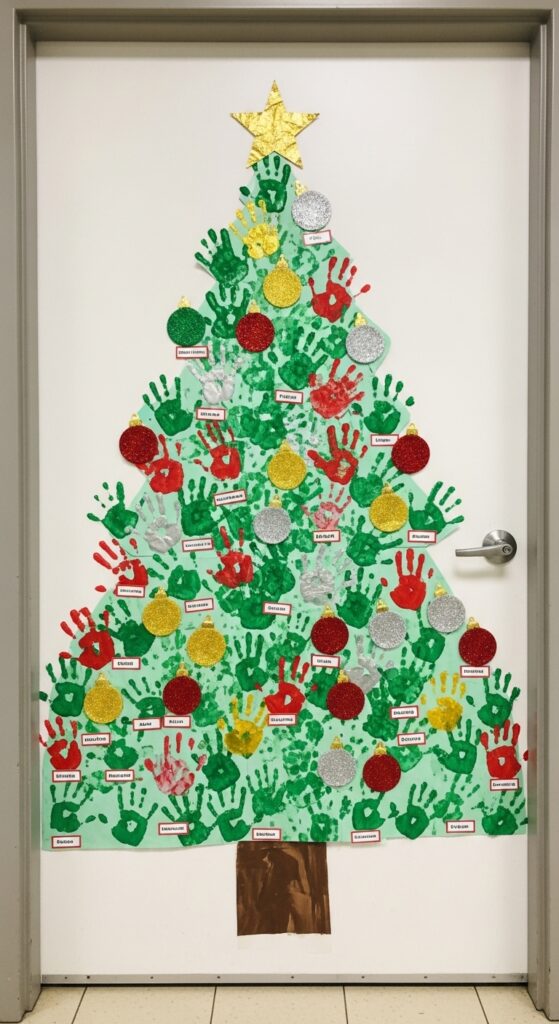
Little hands make big impressions on this collaborative door design perfect for early childhood classrooms. The concept is beguilingly simple: a door-sized triangle forms the base of a Christmas tree, with each child’s painted handprint serving as the “ornaments.”
The beauty lies in its simplicity and inclusivity. Even the youngest students can participate, creating a meaningful display that showcases each class member. Teachers often add personalized touches by writing names and dates on each handprint, transforming the decoration into a keepsake documentation of the class community.
Colors can be customized to any holiday palette, making this adaptable for diverse settings. Some teachers add sensory elements like fabric scraps, buttons, or textured papers to create a tactile experience that young learners can explore throughout the season.
7. Cotton Ball Snow Friends Family
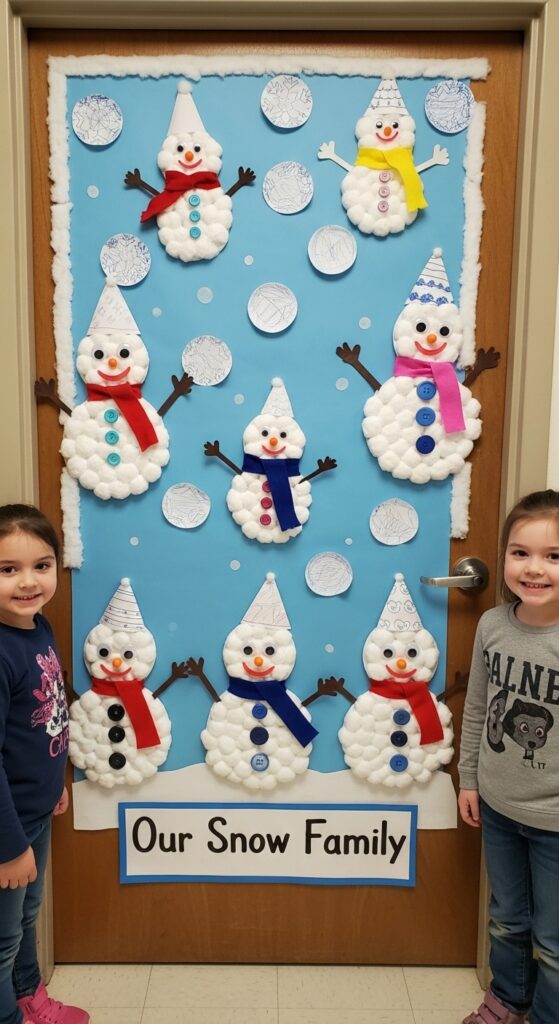
Preschoolers delight in the tactile experience of cotton balls, making this fluffy door decoration a perennial favorite updated for 2025. The concept centers around a family of snow people created primarily from cotton balls glued to construction paper cutouts.
Each student contributes their own small snow person to the display, decorated with buttons, fabric scraps, and pipe cleaner arms. Teachers report that this activity provides valuable fine motor practice while building excitement for the holiday season. The resulting door becomes a celebration of the classroom community, with each child’s creation contributing to the whole.
What makes the 2025 version special is the incorporation of family diversity, with snow people grouped in various family structures that reflect the actual families within the class. This subtle but important update helps young children see their own family structures represented in holiday imagery.
8. Sensory Texture Ornament Door
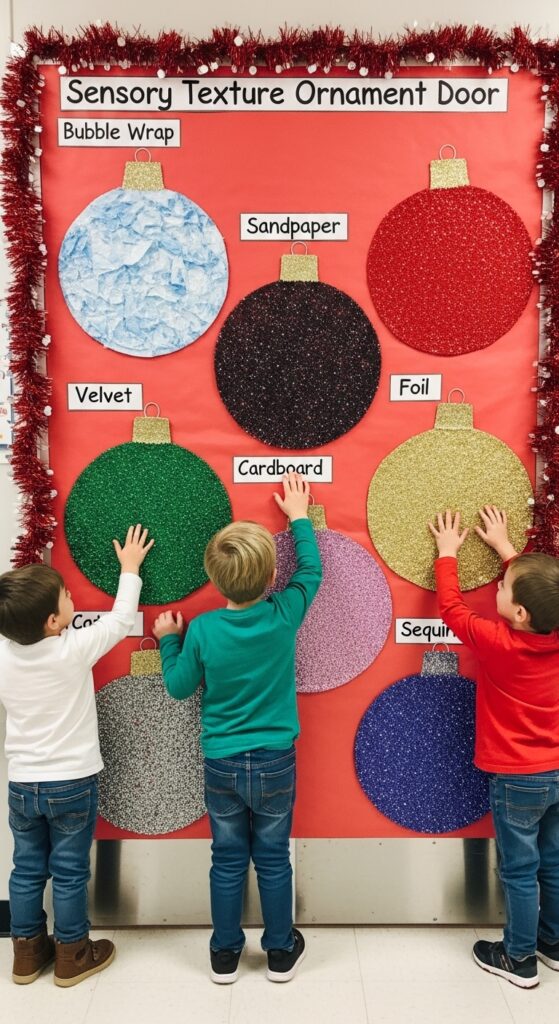
Early childhood educators know that sensory experiences are crucial for development. This door concept transforms the traditional ornament display into a tactile adventure by incorporating different textures into each ornament design.
Each large paper ornament features a different sensory material—sandpaper, bubble wrap, velvet fabric, corrugated cardboard, and metallic papers. Children help create these textured masterpieces and then enjoy exploring them throughout the holiday season. The combinations of colors, patterns, and textures create a visually striking display that also serves developmental purposes.
The accessibility of this design makes it ideal for inclusive classrooms, offering multisensory experiences for all learners. Teachers can extend the learning by labeling textures or incorporating descriptive language activities into the creation process.
9. Peek-a-Boo Present Door
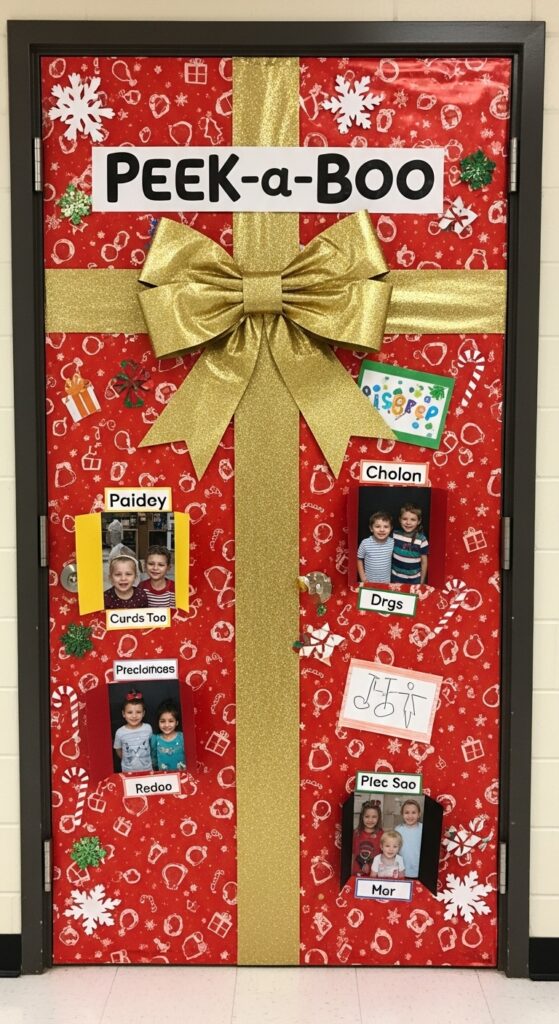
Preschoolers adore surprise reveals, making this interactive door design a guaranteed hit. The base design resembles a large wrapped present, complete with a paper bow and decorative elements. The innovation comes from several “peek-a-boo” flaps cut into the wrapping paper.
Behind each flap, students and teachers place holiday images, photos of class members, or winter vocabulary words. Throughout the season, children can lift the flaps to discover the surprises hidden beneath. This interactive element transforms a static decoration into an engaging activity that builds anticipation and provides language development opportunities.
The simplicity of construction makes this achievable even for teachers with limited crafting experience or tight budgets. Construction paper, scissors, and basic adhesives are all that’s required for the base structure, though embellishments can be added based on available supplies.
10. Character Snow Globe Door
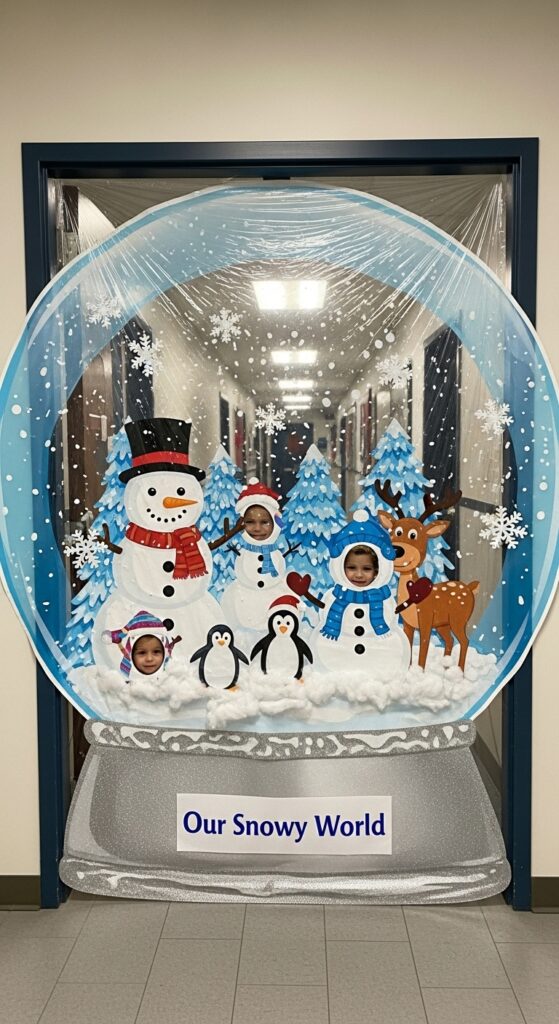
This design cleverly transforms the entire doorway into a giant snow globe, with the door’s window creating a natural viewing area for the scene inside. Simple blue or white paper creates the background, while a constructed base (usually from painted cardboard) forms the snow globe’s bottom.
What makes this particularly suitable for preschool is the opportunity to incorporate familiar characters that young children connect with. Teachers can choose storybook characters from class read-alouds, seasonal figures like snowmen or reindeer, or even photos of the students themselves “trapped” inside the snow globe world.
Added touches like cotton ball snow, glitter (if school policies allow), and three-dimensional elements elevate the basic concept. Some teachers add sensory elements like scented cotton balls or textured materials that young children can safely touch and explore when entering or exiting the classroom.
Disney-Themed Door Decorations
11. Frozen Winter Kingdom
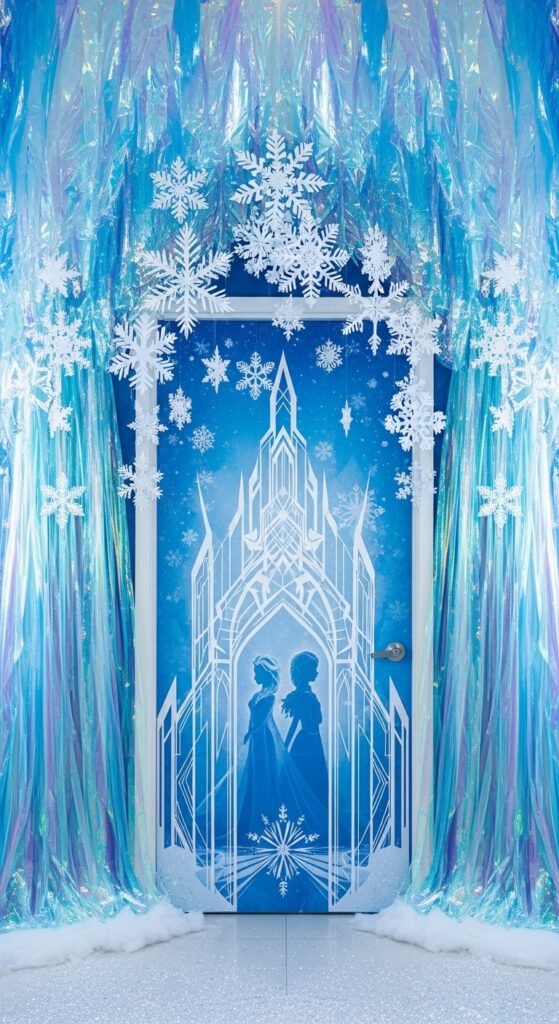
Disney’s Frozen franchise continues to captivate young audiences, making it a natural choice for holiday door decor. The 2025 approach moves beyond simply depicting Elsa and Anna to creating an immersive ice palace entrance that transforms the entire doorway.
Iridescent cellophane creates ice-like structures around the door frame, while paper snowflakes in various sizes add dimensional interest. The door itself becomes the palace entrance, with detailed ice-like patterns created using white paint pens on blue backing paper. Character silhouettes rather than full figures offer a sophisticated approach that works well in upper elementary and middle school settings.
The beauty of this theme is its natural connection to winter without requiring specific Christmas elements, making it appropriate for diverse school communities. The frosty blues and purples create a striking visual impact against typical school corridor colors, and the materials are relatively inexpensive to source.
12. Mickey’s Holiday Workshop
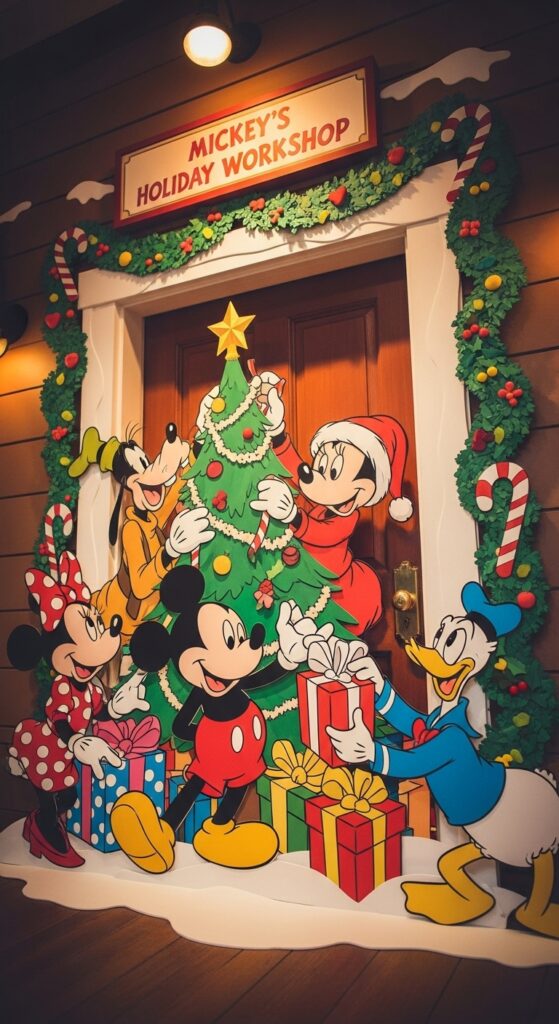
Classic Disney characters have a timeless appeal that works across age groups. This door concept transforms the entrance into Mickey’s workshop, where he and friends are busy preparing for the holidays. The nostalgic approach appeals to both children and adults, creating multi-generational connection points.
The door features Mickey and friends crafting presents, decorating trees, or baking holiday treats. What makes this design successful is attention to Mickey’s classic color palette—red, black, yellow, and white—which naturally aligns with traditional Christmas colors. Character outlines can be projected and traced for those without advanced artistic skills.
Some schools have expanded this concept to include Walt Disney’s birthday (December 5th) celebrations, creating educational tie-ins about animation history and storytelling. This approach transforms a decorative element into a learning opportunity that extends beyond seasonal festivities.
13. Toy Story Christmas Adventure

The beloved Toy Story characters offer rich possibilities for holiday door decorations. The concept positions Woody, Buzz, and friends as they prepare for Christmas, with the door becoming Andy’s room decorated for the holidays. Students particularly enjoy the narrative possibilities inherent in this scenario.
What works beautifully about this theme is the opportunity to incorporate actual toys into the display, creating three-dimensional elements that extend from the door surface. Small wrapped boxes, miniature Christmas trees, and toy-sized decorations add authenticity to the scene. Some teachers add battery-operated string lights for extra magic.
The theme resonates with the core message that objects (and people) can have special meaning beyond their appearance—a valuable lesson during a sometimes materialistic season. This deeper connection elevates the door from simple decoration to meaningful classroom conversation starter.
14. Encanto Family Celebration
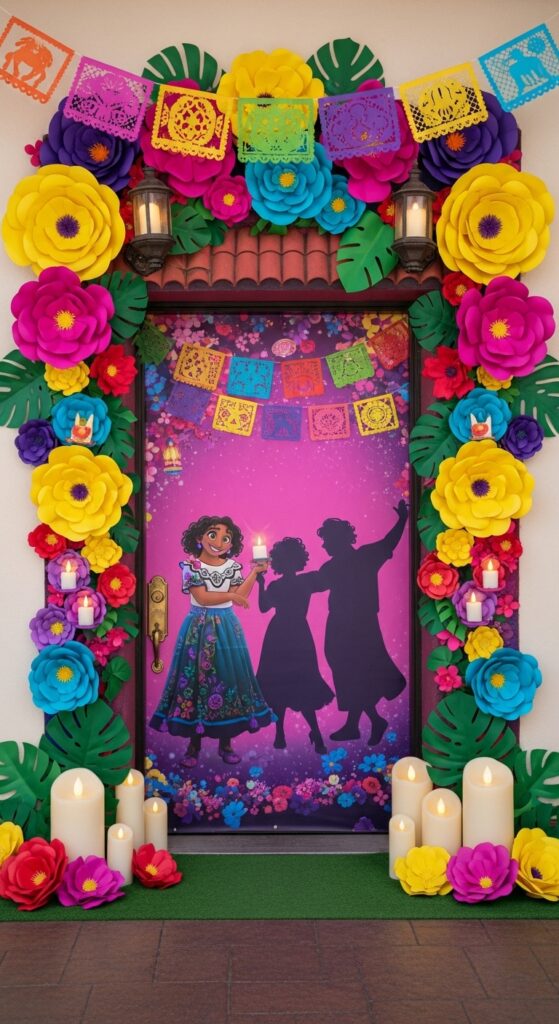
Disney’s Encanto offers a refreshing opportunity to showcase holiday traditions from Colombia, creating both a festive display and a cultural learning experience. The door becomes the entrance to the magical casita, decorated for the holiday season with elements authentic to Colombian Christmas celebrations.
Paper aguinaldos (small gift bags), candles representing the Day of the Little Candles, and nativity scenes incorporate authentic cultural elements. Character silhouettes from the Madrigal family can be arranged around these traditional items, creating a blend of familiar Disney elements and cultural education.
Teachers report that this theme provides valuable opportunities to discuss how different cultures celebrate winter holidays, expanding students’ global awareness. The vibrant colors associated with the film also create visually striking displays that brighten school hallways during the darker winter months.
15. Nightmare Before Christmas Mashup

For schools comfortable with slightly spookier themes, The Nightmare Before Christmas offers a perfect blend of Halloween and Christmas imagery that appeals particularly to older elementary and middle school students. The distinctive visual style of the film translates beautifully to door decorations.
The concept centers around Jack Skellington’s discovery of Christmas, with the door split between Halloween Town and Christmas Town aesthetics. Black and white spiral patterns, stylized snowflakes, and the iconic hill silhouette create instantly recognizable imagery. Some teachers add three-dimensional elements like paper mache pumpkins painted with Christmas designs.
What makes this theme especially appealing is its built-in message about cultural exchange and learning from different traditions—Jack’s fascination with Christmas parallels students’ exploration of diverse holiday customs. The slightly unconventional approach also engages students who might otherwise consider holiday decorations “uncool.”
Grinch-Themed Door Decorations
16. Grinch Heart Growth Meter
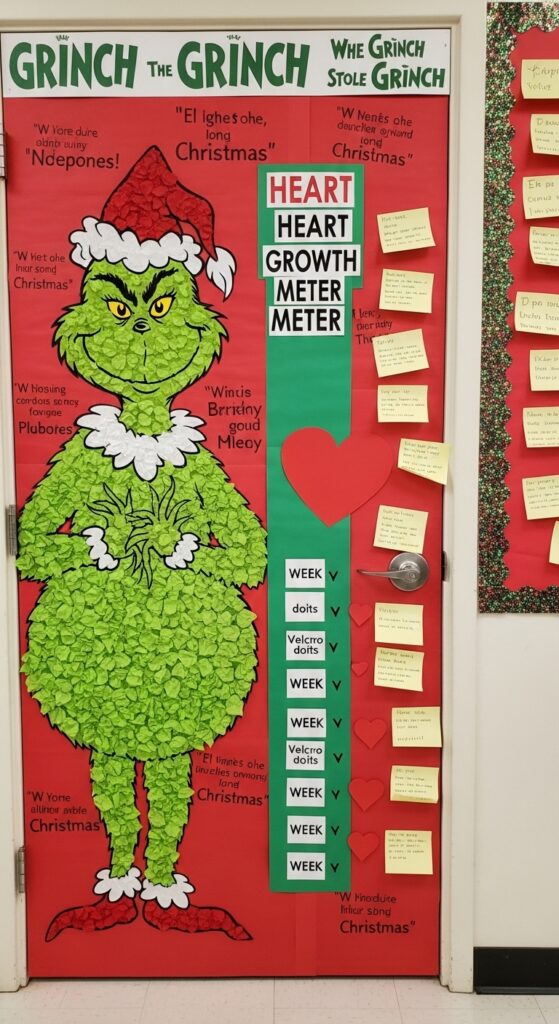
Dr. Seuss’s beloved green grouch offers perfect symbolism for the true meaning of Christmas, making Grinch themes perennially popular in school settings. This interactive door concept centers around the Grinch’s expanding heart, with a measurable component that grows throughout the holiday season.
The door features the Grinch prominently, with a heart cutout that starts small (per the story) and physically expands as the class participates in acts of kindness or community service. Teachers create heart templates in increasingly larger sizes, swapping them out as students reach designated goals. This interactive element transforms the decoration into a teaching tool about generosity and compassion.
Students respond enthusiasticly to this blend of familiar character and meaningful message. The visual representation of “growing” kindness creates powerful concrete imagery that helps young learners grasp abstract concepts of empathy and giving—essential social-emotional skills embedded in a festive package.
17. Whoville Holiday Transformation
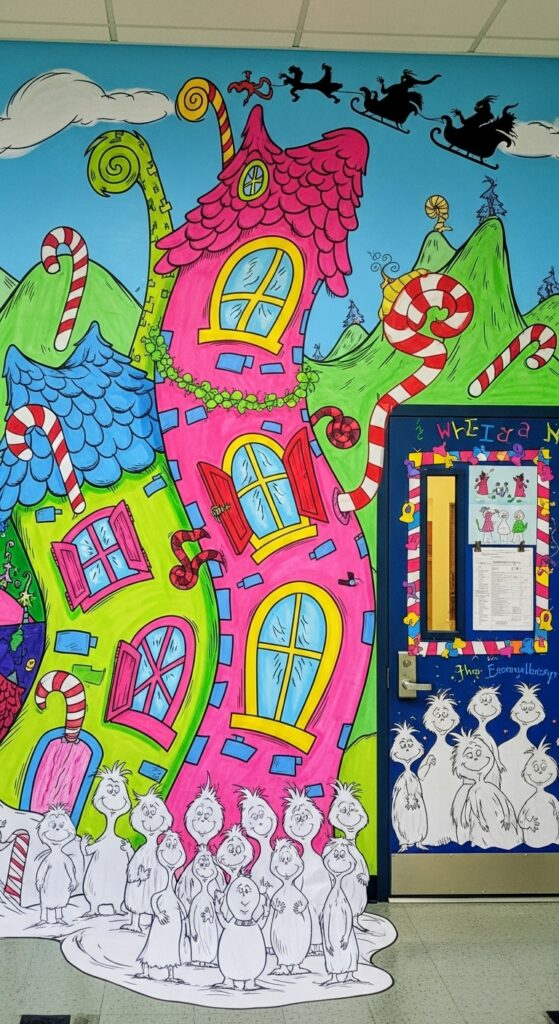
The whimsical world of Whoville provides rich visual inspiration for door decorations that captivate students of all ages. This concept transforms the entire door into a Seussian celebration, complete with crooked windows, curved architectural elements, and the distinctive Whoville aesthetic.
The key to successful Whoville doors lies in embracing the curvy, asymmetrical style that defines Seuss illustrations. Even simple elements like wreaths and garlands should feature unusual proportions and unexpected colors. Teachers report that this theme provides excellent opportunities for discussing literary elements like setting and style while creating festive environments.
What makes this theme especially valuable is its emphasis on joy regardless of material circumstances—the Whos celebrate even after losing their presents, reinforcing that holiday magic comes from togetherness rather than things. This message resonates strongly in school communities where students come from diverse economic backgrounds.
Bringing It All Together: Implementation Tips
Creating memorable door decorations doesn’t require professional artistic skills—just enthusiasm, planning, and community involvement. The most successful displays involve students in the creation process, turning decoration into a learning experience. When kiddos contribute to the design, they develop ownership and pride in their school environment.
Timing matters significantly in door decoration implementation. Starting too early can lead to damaged displays before the holiday season peaks, while beginning too late creates unnecessary stress during an already busy time. Most experienced teachers recommend beginning the planning process in early November and installing displays during the first week of December.
Budget constraints don’t need to limit creativity. Many of 2025’s most innovative designs utilize repurposed materials, dollar store finds, and digital elements that minimize physical supply costs. Some schools have established “decoration stations” where commonly used materials are collected throughout the year, creating sustainable systems for seasonal displays.
Remember that the most impactful door decorations connect to something meaningful—curriculum objectives, character development goals, or community celebrations. When decorations reinforce what students are learning elsewhere, they become powerful educational tools rather than mere hallway dressing. The thoughtful integration of academic content elevates holiday decorating from a seasonal activity to a valuable learning opportunity.
Whether you choose high-tech projections or handprint crafts, contest-worthy extravaganzas or simple preschool creations, the true purpose remains constant—creating joyful, inclusive environments where students feel the magic of the season. These decorated doors become portals not just to classrooms, but to cherished memories that students will carry long after the decorations come down. And isnt that what teaching is all about? Creating magical moments of learning disguised as fun.

Mariana is the founder and voice behind Home Nookery, a curated blog dedicated to home design, décor inspiration, and cozy living. With a passion for creating beautiful, functional spaces, Mariana shares practical tips, styling ideas, and thoughtful insights to help readers turn their houses into homes. Whether you’re redesigning a room or just adding a touch of charm, she’s here to guide you with creativity and heart.
